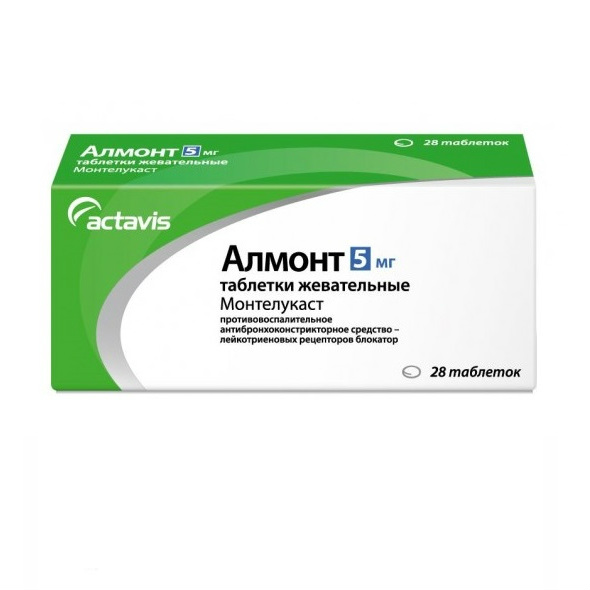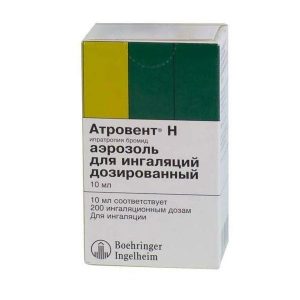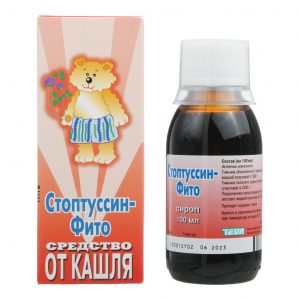Description
Release form
Tablets, 5 mg
Indications
Prevention and long-term treatment of bronchial asthma in children, including:
prevention of day and night symptoms of the disease (for children 2 years of age and older)
treatment of bronchial asthma in patients with hypersensitivity to acetylsalicylic acid (for children from 6 years or older)
warning of bronchospasm, caused by physical activity (for children from 2 years of age and older).
Relief of symptoms of seasonal and perennial allergic rhinitis in children from 2 years.
Contraindications
Hypersensitivity to the active or any auxiliary substance of the drug
children under 2 years of age (for a dosage of 4 mg) and up to 6 years of age (for a dosage of 5 mg)
patients with rare hereditary diseases: galactose intolerance, lactase deficiency or glucose-galactose malabsorption
phenylketonuria (contains aspartame).
Use during pregnancy and lactation
Use of Montelast during pregnancy is possible if the intended benefit to the mother outweighs the potential risk to the fetus.
The decision to abolish breastfeeding for the period of use of the Montelast drug is made on the basis of an assessment of the expected benefits to the mother and the potential risk to the baby.
Special instructions
is NOT recommended for the treatment of acute asthma attacks. Patients with asthma are advised to always have emergency medications with them. In the event of an acute attack, short-acting inhaled beta2-adrenomimetics should be used. Patients should consult their physician as soon as possible if they need more inhalation of short-acting beta2-adrenergic agonists than usual.
Do not abruptly replace the drug with inhaled or oral corticosteroids. There is no evidence proving the possibility of reducing the dose of oral corticosteroids against the background of simultaneous administration.
In rare cases, patients who receive anti-asthma drugs, including montelukast, may develop systemic eosinophilia, which is sometimes accompanied by clinical signs of vasculitis, the so-called Charge-Strauss syndrome, a condition that is eliminated by taking systemic corticosteroids. These cases are usually associated with dose reduction or discontinuation of oral corticosteroids therapy. It is impossible to exclude or establish the probability that leukotriene receptor antagonists may be associated with the development of Charge Strauss syndrome. Therefore, doctors need to be warned about the possibility of eosinophilia, a vascular rash, an increase in the severity of pulmonary symptoms, heart complications and / or neuropathy in patients. Patients who develop the above symptoms need to be re-examined and their treatment regimen reviewed. Treatment with the drug does not lead to the prevention of bronchospasm in patients with hypersensitivity to acetylsalicylic acid, when using acetylsalicylic acid and other NSAIDs.
Montelast contains aspartame, a source of phenylalanine. This drug may be harmful to patients with phenylketonuria.
The drug contains lactose monohydrate and should not be taken by patients with rare hereditary diseases: galactose intolerance, lactase deficiency or glucose-galactose malabsorption.
Influence on the ability to drive vehicles and operate mechanisms
As a rule, montelukast does not affect the ability to drive vehicles or work with other mechanisms, but very rarely drowsiness and dizziness were noted in some patients, when these signs appear, patients are not recommended to drive vehicles and engage in other activities that require concentration and speed of psychomotor reactions.
Composition
Active ingredient: montelukast 5.00 mg (as montelukast sodium 5.20 mg)
excipients: mannitol 201.20 mg, microcrystalline cellulose 66.00 mg, hyprolysis 9.00 mg, croscarmellose sodium 9.00 mg, dye Pigment Blend PB-24880 (lactose monohydrate 4.50 mg, dye iron oxide red 0.50 mg) 5.00 mg, magnesium stearate 3.00 mg, aspartame 1.50 mg, cherry flavor (Silarom Cherry Flavor 1219813182 ) 0.10 mg.
Dosage and administration
Take orally 1 hour before or 2 hours after eating. The tablet should be chewed.
Children take the drug under adult supervision.
Bronchial asthma or bronchial asthma and allergic rhinitis
For children aged 2 to 6 years – 1 chewable tablet 4 mg 1 time / day in the evening.
For children aged 6 to 14 years – 1 chewable tablet 5 mg 1 time / day in the evening.
Allergic rhinitis
For children aged 2 to 6 years – 1 chewable tablet 4 mg 1 time / day
for children aged 6 to 14 years – 1 chewable tablet in a dose of 5 mg 1 time / day individually depending on from the time of the greatest exacerbation of symptoms.
Dose adjustment within these age groups is not required.
The therapeutic effect of Montelast, which allows controlling asthma symptoms, is achieved within 24 hours after administration.
The patient is recommended to continue taking the drug, both during the periods of the controlled course of bronchial asthma, and during the exacerbation of bronchial asthma.
Patients with renal failure and patients with hepatic insufficiency of mild to moderate severity do not need a special dose selection.
There is no data on the use of montelukast in patients with severely impaired liver function. No dose adjustment is required depending on the patient’s gender.
For the treatment of patients of other age groups, a different dosage form and dose of the drug are available – film-coated tablets, 10 mg.
Side effects
Infectious and parasitic diseases: upper respiratory tract infections.
From the blood and lymphatic system: increased tendency to bleeding, thrombocytopenia.
From the side of the immune system: hypersensitivity reactions, incl. anaphylaxis, eosinophilic liver infiltration.
From the psyche: pathological dreams (including nightmares), hallucinations, insomnia, somnambulism, irritability, anxiety, anxiety, agitation (including aggressive behavior or hostility), tremor, depression, disorientation, suicidal thoughts and behavior (suicidality).
From the nervous system: headache, dizziness, drowsiness, paresthesia / hypesthesia, cramps.
From the cardiovascular system: palpitations.
From the respiratory system: epistaxis.
From the digestive system: diarrhea, dry mouth, dyspepsia, nausea, vomiting, abdominal pain, pancreatitis.
From the liver and biliary tract: increased activity of ALT and AST, hepatitis (including cholestatic, hepatocellular and mixed liver lesions).
From the skin and subcutaneous tissues: angioedema, tendency to hematomas, urticaria, pruritus, rash, erythema nodosum, erythema multiforme.
From the side of musculoskeletal and connective tissue: arthralgia, myalgia, including muscle cramps.
Common disorders: asthenia / fatigue, malaise, swelling, pyrexia, thirst.
Other: in very rare cases, during the treatment with montelukast, the development of Charge-Strauss syndrome has been reported.
Drug Interactions
In Patients while receiving phenobarbital, the area under the pharmacokinetic concentration-time curve of montelukast decreased by about 40%, however, correction of the dosage regimen in such patients is not required. Since montelukast is metabolized by the isoenzyme CYP3A4, caution should be exercised, especially in children, if montelukast is used simultaneously with inducers of the isoenzyme CYP3A4, such as phenytoin, phenobarbital and rifampicin.
Montelukast can be prescribed along with other drugs traditionally used for the prevention and long-term treatment of bronchial asthma and / or allergic rhinitis.
Montelukast in the recommended therapeutic dose did not have a clinically significant effect on the pharmacokinetics of the following drugs: theophylline, prednisone, prednisolone, oral contraceptives (ethinyl estradiol / norethinodrel 35/1), terfenadine, digoxin and warfarin.
In vitro studies have found that montelukast is a potent inhibitor of the CYP2C8 isoenzyme. However, when studying the drug interaction in vivo of montelukast and rosiglitazone (a marker substrate, a representative of drugs that are primarily metabolized by the CYP2C8 isoenzyme), there is no confirmation of the inhibition of CYP2C8 isoenzyme by montelukast. Thus, in clinical practice, the effect of montelukast on SUR2C8-mediated metabolism of a number of drugs, including paclitaxel, rosiglitazone, repaglinide.
In vitro studies have shown that montelukast is a substrate of the CYP2C8 isoenzyme, and to a lesser extent the CYP2C9 and 3A4 isoenzymes. Data from a clinical study of drug interactions in relation to montelukast and gemfibrozil (an inhibitor of both CYP2C8 and 2C9) demonstrate that gemfibrozil increases the effect of systemic exposure to montelukast by 4.4 times. The combined administration of itraconazole, a potent inhibitor of the CYP3A4 isoenzyme, together with gemfibrozil and montelukast did not lead to an additional increase in the effect of systemic exposure to montelukast. The effect of gemfibrozil on the systemic effects of montelukast cannot be considered clinically significant based on safety data when used in doses exceeding the approved dose of 10 mg for adult patients (for example, 200 mg / day for adult patients for 22 weeks and up to 900 mg / day for patients taking the drug for about one week did not show clinically significant negative effects). Thus, when combined with gemfibrozil, dose adjustment of montelukast is not required. According to the results of in vitro studies, clinically significant drug interactions with other known inhibitors of the CYP2C8 isoenzyme (for example, with trimethoprim) are not expected. In addition, the combined administration of montelukast with itraconazole alone did not lead to a significant increase in the effect of systemic exposure to montelukast.
Combined treatment with bronchodilators
ALMONT is a reasonable supplement to monotherapy with bronchodilators, if the latter do not provide adequate control of bronchial asthma. Upon reaching the therapeutic effect of treatment with ALMONT, a gradual reduction in the dose of bronchodilators can begin.
Combined treatment with inhaled GCS
Treatment with ALMONT provides an additional therapeutic effect to patients using inhaled GCS. Upon reaching stabilization, a gradual decrease in the dose of corticosteroids can be started under the supervision of a physician. In some cases, the complete cancellation of inhaled GCS is acceptable, however, a sharp replacement of inhaled GCS with ALMONT is not recommended.
Storage conditions
In a dry and dark place, out of the reach of children, at a temperature not exceeding 30 ° C.
Deystvuyuschee substances
montelukast
Terms and conditions
prescription
dosage form
lozenges
Indications
Bronhyalnaya asthma , Nasmurk, Bronchospasm
Actavis Ltd, Iceland




